Designing the Dungeon: Your First Dungeon!
“The torture chamber goes here, dark master?” The grubby goblin pointed to a spot on the dungeon’s blueprints with one hand, then gestured to a wide open plot of land in the excavated cavern. Massive towers of scaffolding propped up the walls of the artificial cave, and the worksite echoed with the sounds of duergar miners digging deeper and goblin laborers dragging massive granite slabs into place.
“No, you senseless rat!” A dark elf, clad in midnight purple robes traced with silver spiderwebs rose from his throne. He grabbed the goblin by its throat as he rose and snarled as he brought the creature to eye level. “I want the adventurers to pass through the torture chamber before they reach the manticore pit! Change the plans, this dungeon must be perfect!”
The drow raised his hand and uttered a word, engulfing the blueprints in violet flame. The goblin holding the blueprints shrieked in alarm, fell backward onto the ground, and fumbled the parchment into the air. The flame that surrounded the roll of parchment shrunk to thin lines of guttering flame, rearranging the ink-drawn walls of the dungeon into a completely different layout.
Thus amended, the parchment fluttered down into the lap of the flabbergasted goblin. The drow slumped back into his throne and crossed his legs. “There are your new orders,” he drawled, waving his spellcasting hand dismissively. “Now go pen me a villainous soliloquy. I must be prepared for the adventurers when they arrive.”
Where do you start when you want to create your first dungeon? It doesn’t matter if you’ve run pre-written adventures for years or if you’re a first-time Dungeon Master creating a dungeon for your own original campaign, creating a dungeon from scratch is hard. Any artist—writer, composer, painter—can tell you how hard it is to put the first mark on a blank page. Let this guide help you put the first blotches of ink on your dungeon map by laying out a process for creating a short dungeon with a cohesive theme.
A Single Sheet of Paper
If I can fit my dungeon prep on a single sheet of paper (front and back), I know I’ve created a level that is clear, concise, and simple. I don’t sweat the details, because I know that my experience in running D&D will help me improvise solutions to the infinite list of edge cases I could never have possibly prepared for. As Mike “SlyFlourish” Shea might say, don’t be afraid to be a lazy Dungeon Master. You can never prepare for everything, so just try to be prepared for anything. You will get better at rolling with the punches as you play more.
This notion of creating a dungeon on a single sheet of paper was inspired by the One Page Dungeon Contest, in which contestants submit a fully runnable dungeon created on a single 8.5”x11” sheet of paper. Incidentally, they’re accepting submissions for their 10th anniversary contest right now, with a deadline of May 1st!
Fortunately, your single-sheet dungeon isn’t bound by any rules, and the only person who needs to be able to read it is you, so feel free to use as much jargon and shorthand as you like.
By the way, if you like tactical combat and detailed maps, I suggest you use a piece of graph paper for making your dungeon. If you prefer Theater of the Mind-style combat and more narrative play, normal notebook or printer paper is just fine.
Brainstorming
The front half of your paper will be your brainstorming side, and the back half will be your preparation side. First, write the name of your dungeon at the top of the paper, or at least leave some space aside for it. Something as simple as “Gnoll Cave” is fine, you can always change it later. Then, divide the rest of the front side of your page into five equal sections, horizontally. Then, draw a single vertical line to divide the sheet into 10 boxes. The boxes on the right should be larger than those on the left. (If you’re doing this in Microsoft Word or a similar word processor, just create a table 5 cells high and two cells wide and expand the table to fit the entire page.)
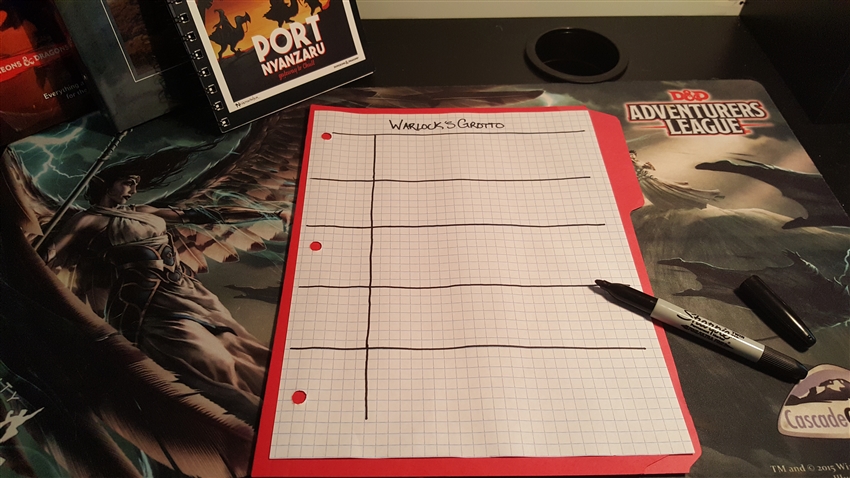
Five Questions
When preparing a news story, journalists ask five main questions: Who, What, Where, When, and Why. Write these questions in the small boxes down the left side of your paper. These questions are short for:
- Who are the significant NPCs in the dungeon? Put simply, who is evil, who is good, and who is neutral?
- What do the inhabitants of the dungeon want? And what have they done? Did the goblins in the dungeon kidnap the blacksmith’s daughter, to paraphrase Matt Colville? Is a warlock performing a ritual of death while her undead servants guard her sanctum?
- Where is this dungeon located, and how does the environment outside affect the inside of the dungeon?
- When was this dungeon originally created? When did its current inhabitants move in? If there is a timed component to this dungeon, how long do the player characters have to accomplish their objective?
- Why are the player characters going to this dungeon?
Don’t feel obligated to fill in these boxes in order from top to bottom. If you think of a great location, write that down first and deal with the other boxes later. This is a brainstorm, so be as messy as you need to be. Fill in the boxes on the right side of the page with notes that answer the question. Be as vague or as specific as you like: you can answer Who? with “a necromancer and some skeletons” or “Prinna Blackwreath, fallen druid-turned-warlock, and the reanimated corpses of her former druidic enclave.”
When answering What? And Why?, try to use active verbs. These questions describe the villains’ and player characters’ motivations, respectively. Villains that are actively doing something evil are more fun for DMs to play and more fun for players to defeat than villains who are simply evil by virtue of being an orc or some other “evil” creature. Likewise, creating active motivations for your players will help you create a dungeon with a clear objective that the players can pursue.
Alternatively, these questions can be posed as simple categories: Cast, Villain Motivation, Setting, Backstory, and Player Motivation/Plot Hooks.
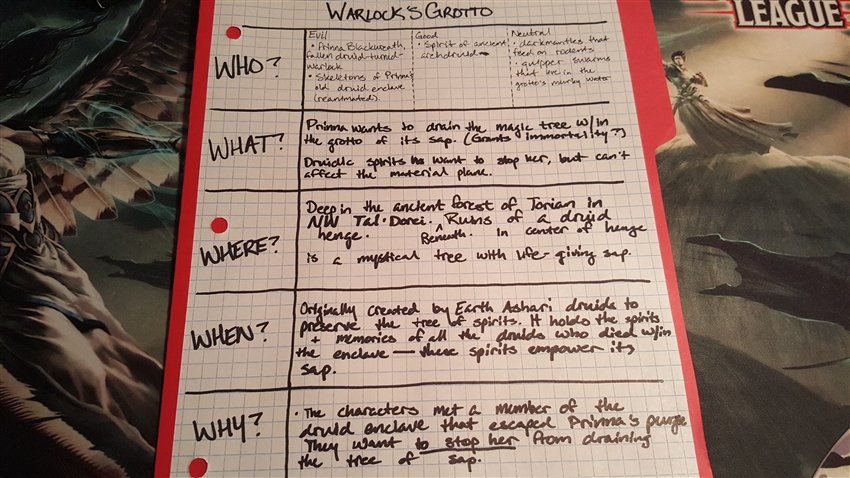
Get Rules on Hand
By filling out this five-question brainstorming table, you’ve identified the basics of your villains and your major NPCs, your plot, your setting, that setting’s history, and how the players are roped into the adventure. If jotting down these notes have inspired you to write more, great! Set aside another sheet of paper to take down additional thoughts as needed.
Now that your brainstorming is complete, make sure you have the rules on hand, especially these chapters and sections from the Player's Handbook, Monster Manual, and Dungeon Master's Guide.
In the Player’s Handbook, Chapter 11: Spells is vital; many traps and monsters use spells. You should know what spells you have at your disposal.
You should always have the entire Monster Manual on hand so you can look at the stats and abilities of the monsters you want to put in your dungeon.
The most important parts of the Dungeon Master’s Guide to have on hand when creating a dungeon are: Creating Encounters and Creating Encounters on a Budget in Chapter 3: Creating Adventures, Dungeons and Mapping a Dungeon and Traps in Chapter 5: Adventure Environments, all of Chapter 7: Treasure, but especially Magic Items, and finally Monster Lists—which lists monsters from the Monster Manual by their native environment and by their challenge rating.
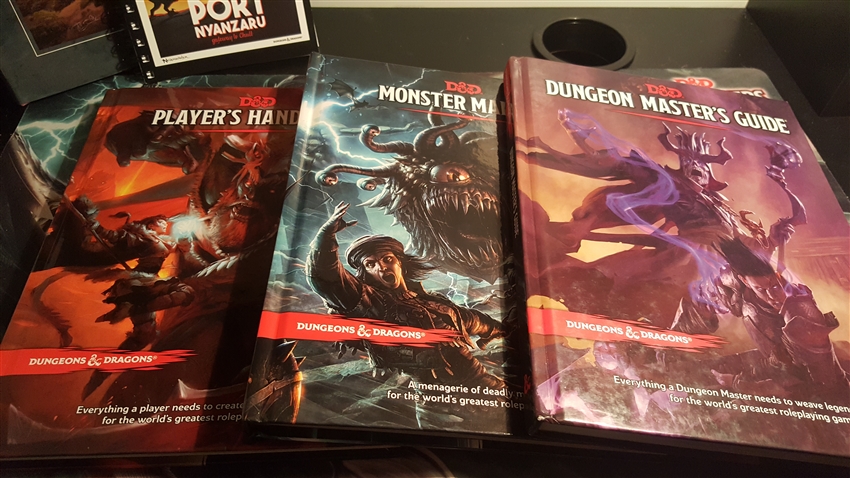
Creating a Dungeon
Now that you have your brainstorm sheet and the rules handy, it’s time to start creating your dungeon. Flip over your sheet of paper. This is the side on which you’ll write everything you’ll need to use when running your dungeon, or at least write page numbers for where to find everything you need. Before you make even a single mark on this side of your page, however, you need to know how big your dungeon will be.
Five Rooms is All You Need
You may want your first dungeon to be your magnum opus, a work to rival the Tomb of Annihilation or the dungeons of Castle Greyhawk. Resist this poisonous urge and tell the demon that whispered it in your ear to sod off back to the Abyss. Your first dungeon should be no more than five rooms (maybe six if you need just a little more room). To the best of my knowledge, the now-classic 5 Room Dungeon formula was first proposed by Johnn Four, and every Dungeon Master in the world should read his 5 Room Dungeon manifesto. Nerds on Earth have also created some sample flowchart-style floor plans for five-room dungeons as well.
Your first dungeon should be a five-ish room dungeon. As Johnn Four asserted back in 2007, a dungeon of this size is small and manageable, easy to pace, and you’ll probably be able to finish it in a single gaming session. Additionally, your game design skills will improve every single time you create a dungeon. It’s better to get a dungeon done, run it, and discard it than it is to start a huge project and realize by the end that you hate the beginning. Design quick, fail faster, and keep improving.
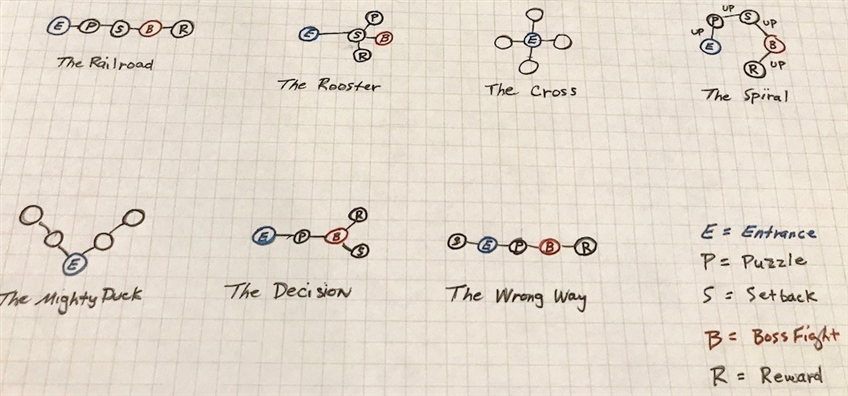
Prepare your Page
Now that you know the size of your dungeon, divide the page into two by drawing a horizontal line about two-thirds of the way down your sheet. Now divide the smaller bottom section into three subsections by drawing two vertical lines. These areas are, from left to right, your Monster Roster, Trap Roster, and Magic Item/Treasure Roster. The space above the rosters is where you’ll draw your map and make notes about the dungeon’s contents.
To Map or Not to Map
If you like tactical combat and using a gridded battle map while playing D&D, you may want to draw your dungeon on graph paper, with each cell of the graph representing a 5-foot square. However, I challenge all first-time dungeon makers to just make a flowchart-style dungeon map like the five-room examples in the Nerds on Earth article. You don’t need to draw out the dungeon in meticulous detail so long as you have a picture in your head, and Theater of the Mind combat is incredibly quick and simple when playing low-level D&D.
That said, you do you. Do what’s easiest and most beneficial to you.
Use the top half of the paper to draw your dungeon map, using whatever five-room dungeon layout you prefer, or one of your own creation, using secret passages and such. Now that you have a floor plan for your dungeon, it’s time to start populating it with monsters, traps, and treasure!
Stocking your Dungeon
Based on your brainstorming earlier, you probably have an idea for at least one or two monsters, NPCs, traps, and magic items.
Monsters
Let’s start with monsters. In the Monster Roster section you created earlier, write down three or four different monsters. Don’t put a monster in your dungeon if its Challenge Rating is higher than the PCs’ average level. You can bend this rule at higher levels, but low-level characters will get slaughtered by overpowered monsters.
In my brainstorming, I came up with a scenario involving a druid-turned-necromancer, her skeleton bodyguards, and some darkmantles native to the dungeon. That’s three good monsters. For a 1st-level dungeon, three monsters might be enough, but since my PCs are 3rd level, I’ve decided to also add zombies and evil druids to the list. My five monsters are:
- Cult fanatic (MM pg. 345)
- Skeleton (MM pg. 272)
- Zombie (MM pg. 316)
- Darkmantle (MM pg. 46)
- Druid (MM pg. 346)
Now that you’ve chosen the monster tools you have to play with, it's time to set up encounters in 2 or 3 of your rooms. Two small combats and one large “boss fight” combat is enough for any dungeon of this size. I’ve made three combats, one introductory combat with 4 skeletons and 2 darkmantles, an optional combat with 4 zombies and 1 evil druid, and one boss encounter with Prinna the cult fanatic, 1 evil druid, and 4 skeletons.
Traps
Traps and puzzles offer a change of pace, giving the players something to think about other than combat and roleplaying. You can raid the Traps chapter of the Dungeon Masters Guide for traps that suit your playstyle, but be careful that the traps you choose won’t kill characters outright. Adjust the damage down for some of the nastier traps if you need to. I took a Poison Needle trap from the Dungeon Masters Guide for my dungeon, and also created a simple trap of my own. There are gigantic roots throughout the dungeon, but one of them has withered. If a character touches it, they must make a DC 12 Constitution save or take 4d6 necrotic damage. A door later in the dungeon has the same magical effect applied to it unless the magic is dispelled or someone can find the deactivation mechanism with a successful DC 12 Wisdom (Perception) check.
I’ve also created a puzzle door with a simple riddle. Answering it correctly results in the door opening, but answering incorrectly deals 2d6 necrotic damage to the guesser. The riddle reads:
I have a crown but no head, limbs but no legs, and rings but no fingers. Speak my name and enter.
Can you guess it? The answer is:
tree.
Pretty obvious, right? Even simple riddles are a fine challenge for most D&D groups. It allows them to feel clever for solving your puzzle, and it keeps the game moving. Snappy puzzles like this are almost always better than long and obtuse ones, unless you know that everyone in your gaming group likes solving challenging puzzles.
I also included a secret passage in another room that allows the characters to bypass this riddle door entirely. This allows them to use game mechanics to overcome the puzzle in case they get stuck.
Magic Items and Treasure
Finally, I included two magic items in this dungeon, but no other treasure. Your dungeon may include some treasure (look at the Treasure chapter of the Dungeon Master’s Guide for suggestions on how to dole out treasure), but mine was in the ruins of a druidic enclave. They have no use for gold coins, but they may have had a use for a magical sickle!
I hid this magic item in the dungeon’s secret passage (making this a six-room dungeon, I suppose), which gives the players a little reward for thoroughly exploring the dungeon. This is a sickle of disruption, which is a simple variation on the mace of disruption in the Treasure chapter of the Dungeon Master’s Guide. Generally, you should give out whatever magic items and treasures you like, but if you’re in need of advice, the Dungeon Master’s Guide has pretty good guidelines on when to hand out magic items. It might be a bit rich to hand out a rare magic item to 3rd level characters, but I think it’s worth it if it’s the only real treasure in the dungeon.
There's also a trapped chest containing a bag of tricks, which is a little booby prize for adventurers who only explore a little.
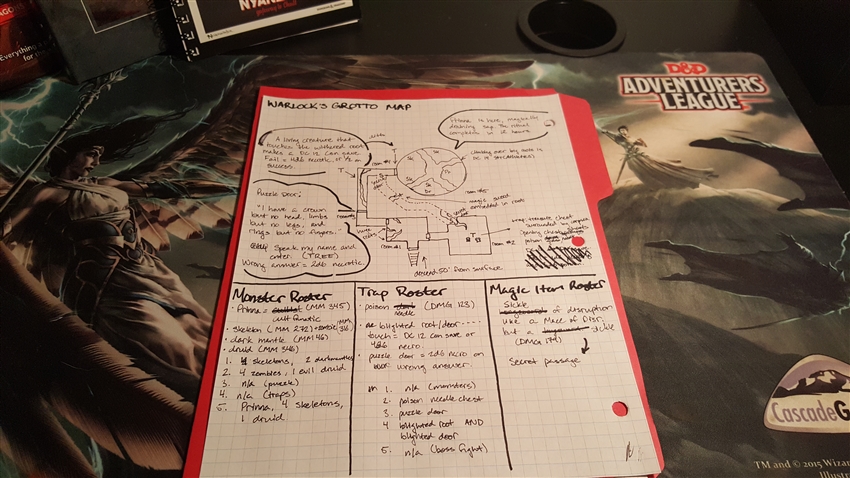
Your Dungeon’s Story and Atmosphere
Every dungeon has a story. The 5 Room Dungeon formula is essentially a five-act narrative structure, complete with rising action, trials, rewards, a climax, and falling action baked right into the rooms of the dungeon! Imbuing your dungeon with its own story, told through monsters, puzzles, and other environmental effects, could be a full article of its own in the future, but for now, just know that every room in your dungeon should reveal a piece of the larger story.
In my dungeon, room 1 is an entrance hall filled with giant roots. There are four obvious enemies—skeletons—and two hidden ones—darkmantles. These skeletons are inside a holy druidic space; something is wrong. The darkmantles are a further sign of evil magic; these creatures are native to the Shadowfell, the shadowy mirror to the Feywild, a place of intense natural magic.
Room 2 has a trapped chest, a secret door, more undead, and an evil druid that has revoked his vows. This alone tells a story, but the druid NPC might also be able to give some cryptic clues to the nature of the true villain: Prinna.
Room 3 features a riddle door crafted by the original creators of this dungeon, the druids of the enclave that Prinna and her betrayers destroyed.
Room 4 is home to a blighted root and a trapped door, showing off the power and consequences of the evil magic being enacted in this dungeon.
Room 5 is filled with baddies, like skeletons, another evil druid, and the mastermind: the cult fanatic Prinna. This fight is the climax of the story, and its denouement comes at the end of that fight when they either prevail and save the great tree Prinna is harvesting the sap from, or when they… well, die in battle.
What’s In Your First Dungeon?
This is far from all there is to know about dungeon design, but hopefully it’s enough to help you start creating a dungeon of your own. What dungeon are you going to create? Or, if you’re a veteran player, what was the first dungeon you ever designed? Tell us about how your heroic players vanquished its monsters and looted its treasure… or how they fled, screaming, from the overpowered creatures within.
Original pictures taken by James Haeck. 5-Room Dungeon Image by Nerds on Earth.
 James Haeck is the lead writer for D&D Beyond, the co-author of the Critical Role Tal'Dorei Campaign Setting, and a freelance writer for Wizards of the Coast, the D&D Adventurers League, and Kobold Press. He lives in a five-room apartment/dungeon in Seattle, Washington with his partner Hannah and his two wandering monsters, Mei and Marzipan. You can usually find him wasting time on Twitter at @jamesjhaeck.
James Haeck is the lead writer for D&D Beyond, the co-author of the Critical Role Tal'Dorei Campaign Setting, and a freelance writer for Wizards of the Coast, the D&D Adventurers League, and Kobold Press. He lives in a five-room apartment/dungeon in Seattle, Washington with his partner Hannah and his two wandering monsters, Mei and Marzipan. You can usually find him wasting time on Twitter at @jamesjhaeck.








-
View User Profile
-
Send Message
Posted Apr 25, 2018Some of your best work here, James. This is a fantastic reference even for more experienced DMs.
-
View User Profile
-
Send Message
Posted Apr 25, 2018Great article. We are about 30-40 hours into a homebrew campaign and my PCs have yet to enter a dungeon. This is perfect timing. Thanks.
-
View User Profile
-
Send Message
Posted Apr 25, 2018Great resource and fun info. Lovin' it. Thank you!
-
View User Profile
-
Send Message
Posted Apr 25, 2018Oh yeah, in the DMG, the Random Dungeon appendix also includes many more tricks and traps than the Traps section of the DMG.
-
View User Profile
-
Send Message
Posted Apr 25, 2018I love theater of the mind, but one of my players can absolutely not carry it out. I hate drawing every room but it's become a necessity. Absolutely worth it, though, when he is able to get a strong grasp on the battlefield and feel confident instead of intimidated.
-
View User Profile
-
Send Message
Posted Apr 25, 2018Very nice! GZ
-
View User Profile
-
Send Message
Posted Apr 25, 2018Obviously the Mindflayer did your mind some good! I remember back in the day there was an accessory full of forms that helped you do exactly this sort of thing. Great advice.
-
View User Profile
-
Send Message
Posted Apr 25, 2018Great article.
-
View User Profile
-
Send Message
Posted Apr 25, 2018This is particularly useful, thanks. I am very new to the DM seat, and to help ease the burden I have been using official adventure modules. Granted, I've been modifying them quite extensively to fit the setting I'm providing, but these published modules do lot of the heavy lifting.
I do want to branch away from that though. I want to use adventure modules for ideas and suggestions, rather than as a crutch to avoid something more of my own creation. This is a helpful article.
-
View User Profile
-
Send Message
Posted Apr 25, 2018Very good article. It could be also used to create some adventures in mountains, forests, swamps, castles etc. Not only classic dungoens.
-
View User Profile
-
Send Message
Posted Apr 25, 2018Damn! Thank you, i don't even know how much i'm grateful for this, i made myself some isometric chart pages to draw maps but all my dungeons end up being too big with a lot of useless rooms, this will help me make more comapct dungeons for action-fun-packed adventures between the main quests. Once again, thank you!
-
View User Profile
-
Send Message
Posted Apr 26, 2018Wow, great stuff, into the gm binder it goes!
What kind of paper are you using that doesn't bleed sharpie?
-
View User Profile
-
Send Message
Posted Apr 26, 2018Being a new DM, my first dungeon was pretty recent. Technically, the pirates' lair hidden in a cave behind a (magically induced) waterfall wasn't a dungeon since they didn't battle anyone, rather encountered an NPC they ended up striking up a bargain with.
But, soon after they found an underground Bullywug lair, where the Bullywug had stolen the lens and lamp oil from the nearby lighthouse (and had been hunting reindeer for wall mounts and pelts, angering nearby Wood Elves). One of our characters is a goody-two-shoes LG Aasimar whose first combat action is always to take a Defensive pose. My favorite part was getting to introduce my homebrewed Bullywug Battlefrog and creating the "Fuzzy" Bag of Tricks. Their favorite parts included setting fire to just about everything thanks to the lamp oil, stealing the chief's "Fuzzy" Bag of Tricks and using it against them, and then the Aasimar blinding and terrifying them all by using her Daylight through the lens while flying with giant angelic wings.
Of course, they chose to reinstall the lens and protect the lighthouse with a simple mechanical lock that (they think) is too high up for Bullywug to reach. Then, they promptly left to adventure elsewhere.
Side note, can someone point me to where I can learn how to link stuff, like I know [ spell ] but I don't know how to do that with an item or a monster.
-
View User Profile
-
Send Message
Posted Apr 26, 2018Boy is this great. Bye far the most helpful article I’ve read on dnd beyond.
-
View User Profile
-
Send Message
Posted Apr 26, 2018Five room formula, huh? Interesting. Maybe I'll give that a try.
-
View User Profile
-
Send Message
Posted Apr 26, 2018This was great, as an experienced DM I had been feeling that the material in these articles was a little too basic, but this one made some really great points and discussed some really interesting ideas, you mentioned that
I'd love if we could see that article happen at some point
-
View User Profile
-
Send Message
Posted Apr 26, 2018Anyone else notice that this dungeon takes place in the world of Tal'dorei? Otherwise known as the world made by Matt Mercer for Critical role.
-
View User Profile
-
Send Message
Posted Apr 26, 2018Since James was the co-author of the Tal'Dorei campaign setting book, this makes sense.
-
View User Profile
-
Send Message
Posted Apr 26, 2018This is by far the best adventure builder I have found. Excellent Job!
-
View User Profile
-
Send Message
Posted Apr 27, 2018Tyrannosary why did you leave the campaign